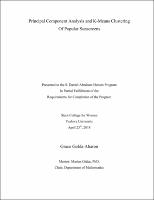Please use this identifier to cite or link to this item:
https://hdl.handle.net/20.500.12202/4455Full metadata record
| DC Field | Value | Language |
|---|---|---|
| dc.contributor.advisor | Gidea, Marian | en_US |
| dc.contributor.author | Aharon, Grace Golda | |
| dc.date.accessioned | 2019-07-03T20:46:25Z | |
| dc.date.available | 2019-07-03T20:46:25Z | |
| dc.date.issued | 2018-04-25 | |
| dc.identifier.citation | Aharon, Grace Golda. Principal Component Analysis and K-Means Clustering Of Popular Sunscreens. Presented to the S. Daniel Abraham Honors Program In Partial Fulfillment of the Requirements for Completion of the Program. Stern College for Women. Yeshiva University. April 25, 2018. | en_US |
| dc.identifier.uri | https://hdl.handle.net/20.500.12202/4455 | |
| dc.identifier.uri | https://ezproxy.yu.edu/login?url=https://repository.yu.edu/handle/20.500.12202/4455 | |
| dc.description | The file is restricted for YU community access only. | en_US |
| dc.description.abstract | Abstract Sunscreen application gains more emphasis every year as a means to defend against sunburns and skin cancer. There are thousands of sunscreens available for consumers to purchase, ranging in price, efficacy, and ingredients. While the use of sunscreen is supported by such organizations as the Unites States Food and Drug Administration (FDA) and the American Academy of Dermatology (AAD), scientific research suggests that certain ingredients in sunscreen pose potential health hazards to the human body. This study assessed the data on popular sunscreens that is available to the average consumer, to extract the most important information and group similar sunscreens together. 62 popular sunscreens were evaluated based on their UVA protection, UVB protection, the accuracy of the SPF advertized, cost per ounce, Consumer Reports rating, and Environmental Working Group (EWG) health rating. Principal component analysis (PCA) was conducted to reduce the dimensionality of the dataset to 3 principal components, accounting for 89.59% of the variance in the data. Notably, the results of the PCA showed that efficacy scores correlated negatively with health scores. K-means clustering was then administered to group sunscreens into 6 clusters. Ultimately, the study identified one cluster with the best quality sunscreens, possessing very high UVA protection; relatively high UVB protection, SPF accuracy, and Consumer Reports scores; and relatively low health EWG ratings; for a high price. | en_US |
| dc.description.sponsorship | S. Daniel Abraham Honors Program for Stern College for Women | en_US |
| dc.language.iso | en_US | en_US |
| dc.publisher | Stern College for Women. Yeshiva University.. | en_US |
| dc.rights | Attribution-NonCommercial-NoDerivs 3.0 United States | * |
| dc.rights.uri | http://creativecommons.org/licenses/by-nc-nd/3.0/us/ | * |
| dc.subject | senior honor thesis | en_US |
| dc.subject | sunscreens | en_US |
| dc.subject | K-means clustering | en_US |
| dc.title | Principal Component Analysis and K-Means Clustering Of Popular Sunscreens. | en_US |
| dc.type | Thesis | en_US |
| Appears in Collections: | S. Daniel Abraham Honors Student Theses | |
Files in This Item:
| File | Description | Size | Format | |
|---|---|---|---|---|
| Senior Project.pdf Restricted Access | submitted by HR/SCW | 2.2 MB | Adobe PDF |  View/Open |
This item is licensed under a Creative Commons License

